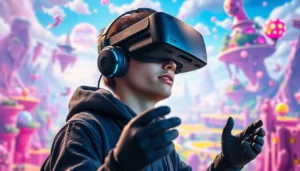Table of Contents
ToggleGamification has taken the world by storm, transforming mundane tasks into engaging adventures. Imagine turning that boring report into a thrilling quest where every completed section earns a badge. Sounds fun, right? This is the magic of gamification, and it’s not just for video games anymore. Businesses, educators, and app developers are jumping on the bandwagon, using game mechanics to boost motivation and engagement.
In the latest gamification news, innovative strategies are popping up faster than a pop-up ad. From fitness apps rewarding users with virtual trophies to corporate training programs that feel like a game show, the landscape is evolving. Whether you’re a seasoned pro or just curious about the buzz, there’s plenty to explore. Get ready to dive into the latest trends and discover how gamification is reshaping our everyday experiences.
Overview of Gamification News
Recent advancements in gamification have reshaped various sectors. Businesses integrate game mechanics to boost employee engagement. For instance, many companies now apply gamified elements in training programs to foster active participation.
Education also embraces gamification trends. Teachers utilize interactive platforms where students earn points for completing assignments. This approach enhances learning and promotes a competitive yet collaborative environment.
Fitness apps continuously evolve, offering users virtual rewards for meeting health goals. These rewards include badges and progress tracking, which motivate users to stay active. Users often report increased adherence to fitness routines due to these engaging elements.
Additionally, gamification practices extend to customer loyalty programs. Brands leverage points systems that incentivize consumer behavior, creating a more rewarding shopping experience. Shoppers feel more invested in brands that recognize their loyalty through gamified rewards.
Moreover, the gaming industry itself experiences gamification. In-game purchases often entail levels and achievements that drive players to spend more. Developers craft experiences that keep players engaged and returning for more challenges.
Trends indicate that gamification will continue to evolve, focusing on personalized experiences. Companies should adopt data analytics to tailor rewards and challenges, ensuring they meet individual user needs. As businesses recognize gamification’s potential, they increasingly implement these strategies to drive engagement across various platforms.
Overall, the current landscape of gamification news highlights its growth and significance across multiple fields. New innovations consistently emerge, emphasizing gamification as a vital tool in enhancing user interaction and satisfaction.
Recent Trends in Gamification

Gamification trends show rapid advancements across various fields. Many organizations implement innovative techniques that enhance user experiences.
Innovations in Gamification Techniques
New gamification techniques utilize elements like augmented reality and artificial intelligence. Incorporating these technologies enriches user engagement. Companies focus on personalized journeys, leveraging data to tailor experiences. For example, fitness apps now offer adaptive challenges based on user progress. Another trend includes social competition features, fostering community interactions. Collaborative elements, such as team challenges, encourage participation and camaraderie. As a result, gamification becomes more dynamic and inclusive. Continuous updates in these techniques enable sustained user interest and motivation.
Popular Platforms Embracing Gamification
Numerous platforms integrate gamification to enhance user interaction. Educational tools like Kahoot engage students through game-based learning. Additionally, productivity apps such as Habitica encourage task completion with RPG elements. E-commerce platforms adopt gamified loyalty programs to incentivize consumer behavior. Many fitness tracking applications use challenges and leaderboards to motivate users. Social media platforms incorporate gamified features, such as badges and rewards, to boost engagement. Brands increasingly recognize the value of gamification in maximizing user experiences and loyalty. This trend indicates a significant shift toward more interactive and enjoyable user journeys.
Impact of Gamification on Business
Gamification significantly influences business strategies by enhancing engagement and motivation among employees and customers. Companies increasingly recognize the value of incorporating game mechanics into their operations.
Case Studies of Successful Gamification
Starbucks successfully integrated gamification into its loyalty program. Customers earn points through purchases, which they can redeem for rewards. This strategy drives customer loyalty and increases the frequency of visits. Another example comes from Duolingo, which uses a tiered point system to motivate language learners. Users compete against each other to climb leaderboards, making learning enjoyable and engaging. Companies like Microsoft also leverage gamification in employee training with interactive modules that promote skill development and engagement. These case studies showcase the effectiveness of gamification in fostering motivation and improving user experiences.
Challenges and Limitations
Despite its advantages, gamification faces challenges in implementation. Some users may perceive gamified elements as superficial or lose interest over time. Understanding user demographics and preferences remains crucial for successful design. Technical limitations can also hinder integration with existing systems, leading to higher costs and complexity. Additionally, overemphasis on competition may discourage collaboration among teams. Businesses must balance gamification elements to ensure they enhance experiences rather than detract from them. Addressing these challenges allows for more effective use of gamification in business.
Gamification in Education
Gamification in education transforms traditional learning environments into dynamic spaces. Teachers increasingly adopt interactive strategies that leverage game mechanics to engage students effectively.
Engaging Learning Through Gamification
Engagement rises significantly when educators incorporate game-based elements in lessons. Students earn points, badges, and rewards for completing assignments, which cultivates a sense of achievement. Online platforms like Kahoot promote quiz competitions, turning assessments into fun challenges. Collaborative activities, such as group projects with gamified components, foster teamwork and enhance social interaction among peers. When students participate in competitive yet supportive environments, learning becomes an enjoyable experience rather than a chore.
Future of Gamification in Education
The future of gamification in education looks promising as technology evolves. Advancements in augmented reality and artificial intelligence offer personalized learning experiences tailored to individual progress. As these technologies integrate with educational platforms, they create immersive learning environments that captivate students’ attention. Institutions will increasingly implement gamified curricula to prepare students for modern challenges. Trends indicate broader acceptance of gamification beyond traditional subjects, incorporating it into STEM fields, the arts, and even mental health education, ensuring comprehensive learning opportunities for all.
Gamification is reshaping how individuals interact with various sectors by making tasks more engaging and enjoyable. As businesses and educators continue to adopt innovative techniques, the potential for enhancing motivation and satisfaction grows. The integration of advanced technologies like augmented reality and artificial intelligence is paving the way for personalized experiences that resonate with users.
Challenges remain in implementing gamification effectively, but the benefits are undeniable. As organizations strive to overcome these hurdles, the future of gamification looks bright. With its ability to foster community, boost engagement, and create rewarding experiences, gamification is set to play an increasingly vital role in driving success across multiple fields.




